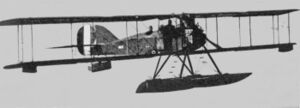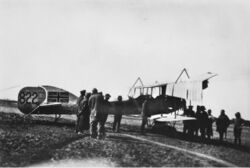Engineering:Short Type 827
The Short Type 827 was a 1910s British two-seat reconnaissance floatplane. It was also known as the Short Admiralty Type 827.
Design and development
The Short Type 827 was a two-bay biplane with unswept unequal-span wings, a slightly smaller development of the Short Type 166. It had a box-section fuselage mounted on the lower wing. It had twin floats under the forward fuselage, plus small floats fitted at the wingtips and tail. It was powered by a nose-mounted 155 hp (116 kW) Sunbeam Nubian engine, with a two-bladed tractor propeller. The crew of two sat in open cockpits in tandem.
The aircraft was built by Short Brothers (36 aircraft,[1]) and also produced by different contractors around the United Kingdom, i.e. Brush Electrical (20), Parnall (20), Fairey (12) and Sunbeam (20).[2]
The Short Type 830 was a variant, powered by a 135 hp (101 kW) Salmson water-cooled radial engine.
Variants
- Type 827
- Production aircraft with a Sunbeam Nubian engine, 108 built.
- Type 830
- Variant powered by a 135 hp (100 kW) Salmson[3] 18 built.[1]
- S.301
- A batch of ten tractor seaplanes, officially listed as Type 830s,[where?] with a 140 hp (104 kW) Salmson-Canton-Unné engine, are sometimes described as Short S.301s after the sequence/construction number of the first aircraft. It was a hybrid design, with the wings and fuselage of the Short Type 166, and the straight-edged ailerons and forward observer's position of the Type 830.[4]
Operators
 Belgium
Belgium
 United Kingdom
United Kingdom
- Royal Naval Air Service
Specifications (Type 827)
Data from Orbis 1985[5]
General characteristics
- Crew: two (pilot, observer)
- Length: 35 ft 3 in (10.74 m)
- Wingspan: 53 ft 11 in (16.43 m)
- Height: 13 ft 6 in (4.11 m)
- Wing area: 506 sq ft (47.0 m2)
- Empty weight: 2,700 lb (1,225 kg)
- Gross weight: 3,400 lb (1,542 kg)
- Powerplant: 1 × Sunbeam Nubian water-cooled V-8 engine, 150 hp (110 kW)
Performance
- Maximum speed: 62 mph (100 km/h, 54 kn)
- Endurance: 3 hr 30 min
Armament
- Guns: 1 x .303 Lewis Gun on flexible mount in rear cockpit
- Bombs: Provision for light bombs on underwing racks
See also
Related development
- Short Type 166
Related lists
- List of aircraft of the Royal Naval Air Service
- List of flying boats and floatplanes
Notes
Bibliography
- Barnes C.H. & James D.N (1989). Shorts Aircraft since 1900. London: Putnam. p. 560. ISBN 0-85177-819-4.
- Bruce, J.M (1956). "The Short Seaplanes: Historic Military Aircraft No 14: Part II". Flight (21 December 1956): 965–968. http://www.flightglobal.com/pdfarchive/view/1956/1956%20-%201804.html.
- Bruce, J.M (1957). "The Short Seaplanes: Historic Military Aircraft No 14: Part IV". Flight (4 January 1957): 23–24. http://www.flightglobal.com/pdfarchive/view/1957/1957%20-%200023.html.
- Klaauw, Bart van der (March–April 1999). "Unexpected Windfalls: Accidentally or Deliberately, More than 100 Aircraft 'arrived' in Dutch Territory During the Great War". Air Enthusiast (80): 54–59. ISSN 0143-5450.
Further reading
- Taylor, Michael J. H. (1989). Jane's Encyclopedia of Aviation. London: Studio Editions. p. 801.
- The Illustrated Encyclopedia of Aircraft (Part Work 1982–1985). Orbis Publishing.
External links
- Short 827 – British Aircraft Directory
 |



